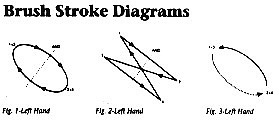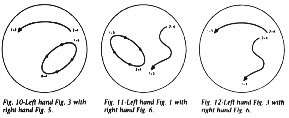Welcome to PaulWertico.com!
Brush Basics
Combining Simple Strokes For Maximum Effect
Anyone thinking that brushes should be used only in ballad playing should think again. Brushes have been used in almost all styles of music, at all tempos, in all dynamic settings. Because of their construction, brushes actually allow you more sound possibilities than sticks or mallets. The key is to master the sound and rhythms of the various swishes, taps and sweeps, and to visualize movements of grace and beauty.
Types of Brushes. There's quite a variety of brushes on the market. There are wire brushes with varying degrees of both wire width and flexibility. There are plastic brushes of various weights and lengths. There also are wire brushes that have a "mallet" type of handle. Right now, I prefer plastic brushes for most playing and wire brushes of medium width for ballads and more sensitive playing. Experimentation is the key.
Heads. Obviously, coated heads are a must for brushes since friction is what makes much of the sound. Your heads should be in good shape with no "dead spots" or pin holes. New heads sometimes can be too rough, so what I usually do is run over a new head lightly with sandpaper to smooth out any rough spots. This lets the brushes glide evenly and smoothly over the head.
Left- and Right-hand strokes. Okay, now for the "meat and potatoes" part. Instead of writing out one or two basic brush beats, I will explain three important brush strokes for each hand. After mastering each one, you can combine different ones according to style and tempo. You will then have a very usable basic brush vocabulary. Hold the brushes as you would hold your sticks.
Left-hand Strokes. The left-hand part is extremely important since it usually does the swishing motion, and that separates the beginner from the pro. When the brush is swishing on the drum, regardless of whether it's a side-to-side motion or a circular motion, there is an inherent rhythm that should remain consistent and "rhythmic". This is achieved by regular practice.

Figs. 1 and 2 are good for general playing. Glide the brushes on the head lightly and try to arrive at each count exactly in time. Soon you will hear the rhythm that the motions create. Fig. 3 is good for ballads and medium tempos. Here the brush glides on the head only from beats two to three, and from four to one.
Right-hand Strokes. The right hand usually plays a counter-rhythm over the left-hand stroke. Where the left-hand movement is sort of left-to-right, left-to-right, the right-hand motion is usually right-to-left, right-to-left.

Fig.4 is a standard jazz ride rhythm. The right hand passes from right (on one and three) to left (on two and four) with the "ah" slightly before the one and three. Try it with left-hand Figs. 1 and 2. Fig. 5 is sort of a mirror image of the left-hand Fig. 2 pattern. Try it with left-hand Figs. 2 and 3. Fig. 6 is an S-type pattern that works great with left-hand Figs. 1 and 3. Figs. 7-12 provide additional practice at combining hands.


On all the left- and right-hand stroke examples, strive for a smooth, even motion and sound, and remember that where your brush is between beats is as important as where it is on the beats. A great way to practice this is to draw a full-size diagram of each of the above figures and practice it slowly until you get the feel. Tape recording yourself also will help a great deal.
I hope this column has gotten you interested in brushes and, as I said earlier, these six figures will give you a basic vocabulary. There are countless other figures you can come up with, so experiment on your own. Also try using the tip of the brush, the body of the brush, lifting the brush off the head, or digging the brush into the head. Doing these types of things gives you many more sound options.
Thanks for your time and best of luck! I'll look forward to being inspired some day by one or more of you.
Images and Information from Drums & Drumming October/November 1989, page 64